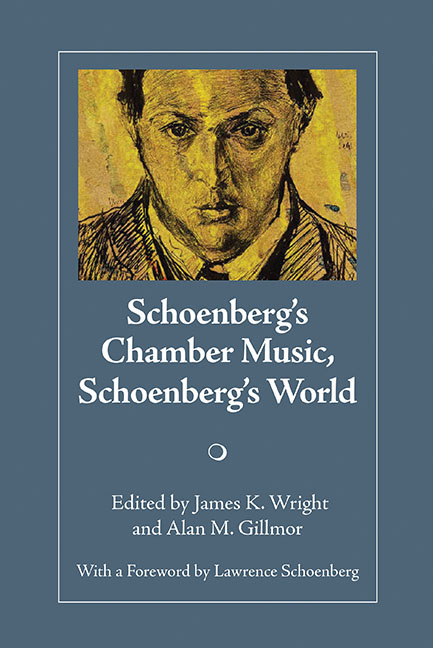Book contents
- Frontmatter
- Contents
- Foreword
- Preface
- HISTORICAL PERSPECTIVES
- ANALYTICAL PERSPECTIVES
- Schoenberg as Webern: The Three Pieces for Chamber Orchestra, III (1910)
- Juxtaposing Popular Music in the Second String Quartet, Op. 10
- A Chronology of Intros, an Enthrallogy of Codas: The Case of Schoenberg's Chamber Symphony, Op. 9
- Schoenberg's First Chamber Symphony, Formalism, and Adorno's Critique of Twelve-Tone Composition
- Precedents of Schoenberg's Compositional Practice in the Chamber Works of Joseph Haydn
- OTTAWA SYMPOSIUM AND CHAMBER MUSIC FESTIVAL PHOTOS
- PERFORMANCE, RECEPTION, AND INTERNATIONAL INFLUENCE
Schoenberg as Webern: The Three Pieces for Chamber Orchestra, III (1910)
from ANALYTICAL PERSPECTIVES
- Frontmatter
- Contents
- Foreword
- Preface
- HISTORICAL PERSPECTIVES
- ANALYTICAL PERSPECTIVES
- Schoenberg as Webern: The Three Pieces for Chamber Orchestra, III (1910)
- Juxtaposing Popular Music in the Second String Quartet, Op. 10
- A Chronology of Intros, an Enthrallogy of Codas: The Case of Schoenberg's Chamber Symphony, Op. 9
- Schoenberg's First Chamber Symphony, Formalism, and Adorno's Critique of Twelve-Tone Composition
- Precedents of Schoenberg's Compositional Practice in the Chamber Works of Joseph Haydn
- OTTAWA SYMPOSIUM AND CHAMBER MUSIC FESTIVAL PHOTOS
- PERFORMANCE, RECEPTION, AND INTERNATIONAL INFLUENCE
Summary
Schoenberg composed what are now known as his Three Pieces for Chamber Orchestra in 1910, following the extraordinary music he composed in 1909: the expressionist monodrama, Erwartung, Op. 17 and Die glückliche Hand, Op. 18. The eminent Danish scholar Jan Maegaard gives the dates of composition of the first two of the brief chamber orchestra pieces as 8/2 1910. The date of the third movement—the topic of the present essay—and its grouping with the first two movements—is somewhat more problematic. Maegaard writes as follows:
The 8-bar complete fragment of the third piece is found on folio 2, p. 1; p. 2 has instrumental indications but no clef and no noteheads. Although the fragment is undated and although it was obviously not written with the same pen as Pieces I and II, and therefore probably not on the same day, there are two features that substantiate membership with the first two pieces. The first and most decisive is the pagination. The continuous pagination 1-4 on the first and second of the two leaves permits the third piece to appear as a continuation of I and II. Further, the tempo indications are similar: I: Rapid Quarters; II: Moderate Quarters ….
Why did Schoenberg compose these short orchestral pieces? The older Schoenberg literature, which either pays little attention to these works or ignores them altogether, does not provide significant clues to an answer to this question. For example, in his standard catalogue, Josef Rufer cites Three Short Pieces for Chamber Orchestra (the third incomplete) (1910). This listing confirms the dates of these intriguing works, but does not interpret their significance within Schoenberg's oeuvre, the primary concern of the present paper.
Recent discussions of the Three Short Pieces are relatively brief. Of these, I will comment on only two. The first appears in an editorial comment by Joseph Auner: ”… the posthumously published Three Pieces for Chamber Orchestra, from February 1910, were left as fragments.” This gloss is only partially accurate. Only the third piece was not completed, or, more likely, the completion was lost. The facsimile published along with the edition of the Three Short Pieces by Belmont Music Publishers shows that the fragment breaks off exactly at the end of a manuscript page, strongly suggesting that the continuation is missing.
- Type
- Chapter
- Information
- Schoenberg's Chamber Music, Schoenberg's World , pp. 55 - 64Publisher: Boydell & BrewerPrint publication year: 2009



